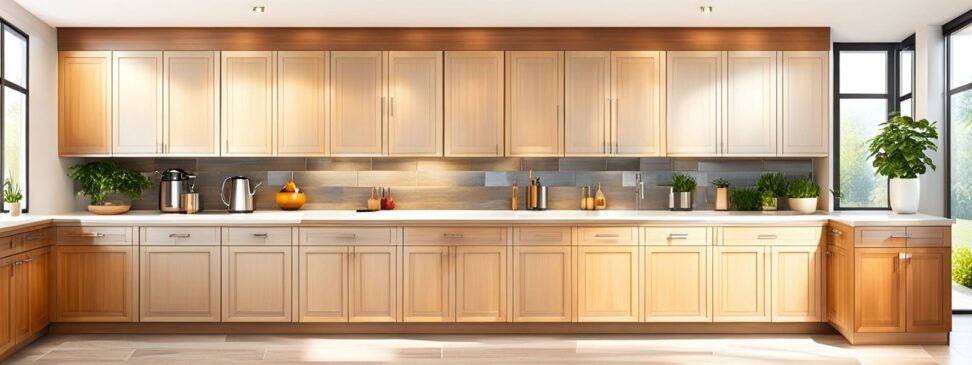The Complete Guide to Picking the Perfect Kitchen Cabinet Color
Choosing the right cabinet color is one of the most important decisions when designing your dream kitchen. The perfect cabinet color can transform the entire look and feel of your kitchen. But with so many color options to consider, how do you pick the ideal shade? This complete guide will walk you through everything you need to know to confidently select cabinet colors that complement your style, space, and needs.
We'll start by looking at popular color trends and finish options. Then we'll explore how different colors impact the ambiance of your kitchen. You'll learn how to leverage color psychology to stir certain emotions. We'll also cover complementary color schemes that work well together. And you'll get tips tailored to small kitchens and white kitchens. By the end, you'll understand all the factors that go into choosing the perfect cabinet color.
Current Kitchen Cabinet Color Trends
Most Popular Cabinet Colors Right Now
If you want a fashionable, on-trend kitchen, consider these popular cabinet color choices:

- White - A classic option that feels clean and bright.
- Gray - From light silvery grays to charcoal, gray evokes sophistication.
- Navy - Deep blue cabinets add personality and flair.
- Black - Striking and dramatic against stainless steel.
- Wood tones - Rich stains ranging from light oak to dark walnut.
Finish Trends
When it comes to cabinet finishes, matte and satin looks are dominating over high-gloss right now. Matte finishes feel more subtle and natural versus the bold shine of gloss cabinets.
How Cabinet Color Impacts Your Kitchen's Look and Feel
Light vs. Dark Cabinets
Lighter colored cabinets tend to make kitchens feel more open and spacious. The pale hues reflect light around the room. White, light gray, tan, and soft yellow are great light color options. Darker cabinets like navy, black, or dark brown can feel elegant and striking. But too much dark color could make a small kitchen feel closed in.
Cool vs. Warm Undertones
Cabinets with warm undertones like reds, oranges, and yellows give off an energizing, welcoming vibe. They make you feel happy and cozy. Cool-toned cabinets such as shades of blue, green, and purple have a more relaxing effect. They evoke feelings of tranquility and sophistication.
Glossy vs. Matte
High-gloss cabinetry has a sleek, polished look. The shine gives any kitchen a touch of glamour. Matte cabinets have a more homey, subtle appearance. The muted finish looks refined yet understated.
Using Color Psychology to Choose Cabinet Colors
Emotional Impacts of Color
Color psychology reveals how different hues subconsciously impact moods. When selecting cabinet color, consider the vibe you want to cultivate. Reds feel lively and passionate. Yellows create happiness and cheer. Blues evoke calmness and relaxation. Pick colors that elicit desired emotions.
Leveraging Color Meanings
Beyond emotions, colors also carry symbolic meanings. For example, green represents renewal and harmony. White embodies clarity and purity. Gray denotes sophistication and wisdom. Look for cabinet colors that align with the meaning you want your kitchen to emanate.
Popular Color Schemes and Combinations
Monochromatic
One easy way to choose cabinet colors is to use a monochromatic scheme featuring shades, tones, and tints of one color. This creates a cohesive, harmonious look. For example, pair navy cabinets with a lighter blue backsplash.
Complementary Colors
Complementary colors sit opposite each other on the color wheel, like red and green or blue and orange. When paired, they create a vibrant, energetic vibe. Just be sure not to use equal amounts of both colors.
Analogous Colors
Analogous schemes use hues located side-by-side on the color wheel, such as blue, blue-green, and green. This provides a balanced, harmonious blend. Analogous colors effortlessly coordinate.
Neutrals with Bold Accents
For a look that's classic yet bold, try a neutral cabinet color like white or gray paired with pops of brighter accent colors. This works well in appliances and backsplashes. It keeps the space feeling timeless but energetic.
Tips for Small Kitchens
When dealing with a small kitchen layout, stick to one or two cabinet colors to avoid a cluttered look. Neutral hues like white, tan, or gray open up the space and reflect light. Avoid bold or dark colors that can overwhelm tight quarters.
Cabinet Color Combinations for White Kitchens
White kitchen cabinets pair beautifully with shades of gray, navy, blue, black, green, red, wood tones, and more. The clean white backdrop acts as a neutral foil, allowing bolder cabinet colors to really pop. For a coordinated look, opt for a neutral countertop that won't compete with colorful cabinets.
Painted vs. Stained Cabinets
Painted
Painted cabinets provide endless color options, even bold brights. For durability, use cabinet-grade paints that resist chipping and yellowing. Eggshell or satin finishes are ideal, not glossy.
Stained
Staining wood cabinets allows you to tint the natural grain to warm shades like cherry, walnut, mahogany, and more. Consider a "gel stain" for an evenly saturated color.
Follow this sequence when selecting coordinating cabinet, countertop, and accent colors:
- Choose your cabinet color first since cabinets take up the most visual space.
- Then select a countertop hue that pairs well with your cabinets.
- Finally, pick complementary backsplash and accent colors to tie the whole palette together.
Choosing the perfect kitchen cabinet color requires carefully considering many factors: space, lighting, color psychology, trends, and more. This guide provided tips to help you select hues tailored to your unique style and needs. Trust your instincts, experiment with color combinations, and you'll create a kitchen that you'll love.